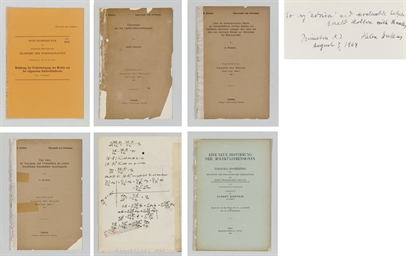EINSTEIN, ALBERT. 1879-1955. 4 Typed Letters Signed ("A Einstein"), with an additional TL featuring stamped signature, to Cleveland E. Dodge offering early reports, each 280 x 216 mm, October 19, 1946 to April 29, 1947, on Emergency Committee letterhead, centerfold. IMPORTANT ARCHIVE OF FUNDRAISING LETTERS OFFERING A GLIMPSE OF POST-ATOMIC URGENCY. At the end of World War 2, Einstein, the world's greatest scientist, was aghast at the dropping of the atomic bomb, and took great pains to justify his role in its creation. His expression of the relationship between mass and energy ("E=mc2") had allowed scientists to unlock the enormous power locked within the atom, and in the early 1930s physicists had already begun to explore the weaponization of the atom. In his famous 1939 letter written with Leo Szilard, he informed Roosevelt of the impending threat and urged a concerted US scientific response, inadvertently leading Roosevelt to create the Manhattan Project. Although Einstein never worked on the US atomic bomb efforts, his name became visibly associated with the effort culminating in the Time Magazine cover of Einstein foregrounding a mushroom cloud emblazoned with his famous equation. Following the war, Einstein, again with Szilard, founded the Emergency Committee of Atomic Scientists to make the public aware of the dangers of nuclear weapons, and to promote the peaceful employment of nuclear power. The fundraising letters are full of the urgency of the moment, beginning with a reference to his now famous 1946 telegram, and ending, "At stake is the fate of our civilization ... let us resolve that nothing we can do shall be left undone in this struggle to preserve ... the civilization which generations of mankind have builded through the centuries." In his description of the November 17th conference, and regretting Dodge's absence, he does note the spirit that prevailed in the face of "not hopeful topics," quoting John Hersey "The one thing in the human being against which he has no defense at all is hope." He goes on to quote Harold Urey on the enormousness of the project at hand: "The task is great, but we must succeed; for only in this way can any of us go back to the quiet and secure life which we had before those fateful bombs fell on Hiroshima and Nagasaki...." While similar letters were sent to other people of importance, examples of these typed and signed letters are uncommon, and more so in the market. An important collection of letters, poignantly capturing an important moment of American and world crisis.
EINSTEIN, ALBERT. 1879-1955. 4 Typed Letters Signed ("A Einstein"), with an additional TL featuring stamped signature, to Cleveland E. Dodge offering early reports, each 280 x 216 mm, October 19, 1946 to April 29, 1947, on Emergency Committee letterhead, centerfold. IMPORTANT ARCHIVE OF FUNDRAISING LETTERS OFFERING A GLIMPSE OF POST-ATOMIC URGENCY. At the end of World War 2, Einstein, the world's greatest scientist, was aghast at the dropping of the atomic bomb, and took great pains to justify his role in its creation. His expression of the relationship between mass and energy ("E=mc2") had allowed scientists to unlock the enormous power locked within the atom, and in the early 1930s physicists had already begun to explore the weaponization of the atom. In his famous 1939 letter written with Leo Szilard, he informed Roosevelt of the impending threat and urged a concerted US scientific response, inadvertently leading Roosevelt to create the Manhattan Project. Although Einstein never worked on the US atomic bomb efforts, his name became visibly associated with the effort culminating in the Time Magazine cover of Einstein foregrounding a mushroom cloud emblazoned with his famous equation. Following the war, Einstein, again with Szilard, founded the Emergency Committee of Atomic Scientists to make the public aware of the dangers of nuclear weapons, and to promote the peaceful employment of nuclear power. The fundraising letters are full of the urgency of the moment, beginning with a reference to his now famous 1946 telegram, and ending, "At stake is the fate of our civilization ... let us resolve that nothing we can do shall be left undone in this struggle to preserve ... the civilization which generations of mankind have builded through the centuries." In his description of the November 17th conference, and regretting Dodge's absence, he does note the spirit that prevailed in the face of "not hopeful topics," quoting John Hersey "The one thing in the human being against which he has no defense at all is hope." He goes on to quote Harold Urey on the enormousness of the project at hand: "The task is great, but we must succeed; for only in this way can any of us go back to the quiet and secure life which we had before those fateful bombs fell on Hiroshima and Nagasaki...." While similar letters were sent to other people of importance, examples of these typed and signed letters are uncommon, and more so in the market. An important collection of letters, poignantly capturing an important moment of American and world crisis.






.jpg)
.jpg)







Testen Sie LotSearch und seine Premium-Features 7 Tage - ohne Kosten!
Lassen Sie sich automatisch über neue Objekte in kommenden Auktionen benachrichtigen.
Suchauftrag anlegen